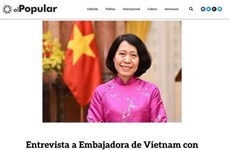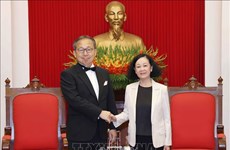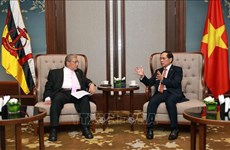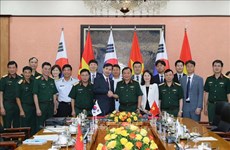Vinashin collapse gives State a lesson
The collapse of the Vietnam Shipbuilding Industry Group (Vinashin) has
forced the Government to restructure State-run groups and provided
valuable lessons for their extensive development, says an official.
The collapse of the Vietnam Shipbuilding Industry Group (Vinashin) has
forced the Government to restructure State-run groups and provided
valuable lessons for their extensive development, says an official.
Tran Tien Cuong, director of the Central Institute for Economic Management's enterprise renovation and development department, made the statement at a conference on the State-owned group model during the renewal period in Vietnam , held in Hanoi on Oct.19
The Chairman of the Vietnam National Oil and Gas Group, Dinh La Thang, pointed out some of the shortcomings in the group model, saying that it was too similar to the former corporation model.
"A legal framework related to group activities has not been completed and there are no separate and specific rules between State administration governance and State capital ownership," Thang said.
With experience from the Republic of Korea and China , it was essential to build and develop the groups more intensively, control extensive development, avoid inappropriate mergers and acquisitions as well as avoid multi-sector investment and only focus on investment in core business, Cuong said.
Director of Vinashin's technical department Ngo Tung Lam also agreed that one of the solutions to improve the governance of the groups was to avoid multi-sector investment, especially in risky areas that could cause major losses and stretch unqualified human resources.
It was also necessary to build a system to supervise and investigate the groups' assets and State capital as well as the capacity of their leaders, Lam said.
Nguyen Dinh Phan, former rector of the Hanoi National Economics University , claimed:"Co-operation between affiliates in each group is still loose and their business effectiveness is low."
Phan advised that more measures were needed to legalise group activities, including increased autonomy in subsidiary management and an independent agency to supervise the groups. Since 2006, a dozen groups have been established in various key economic sectors./.
Tran Tien Cuong, director of the Central Institute for Economic Management's enterprise renovation and development department, made the statement at a conference on the State-owned group model during the renewal period in Vietnam , held in Hanoi on Oct.19
The Chairman of the Vietnam National Oil and Gas Group, Dinh La Thang, pointed out some of the shortcomings in the group model, saying that it was too similar to the former corporation model.
"A legal framework related to group activities has not been completed and there are no separate and specific rules between State administration governance and State capital ownership," Thang said.
With experience from the Republic of Korea and China , it was essential to build and develop the groups more intensively, control extensive development, avoid inappropriate mergers and acquisitions as well as avoid multi-sector investment and only focus on investment in core business, Cuong said.
Director of Vinashin's technical department Ngo Tung Lam also agreed that one of the solutions to improve the governance of the groups was to avoid multi-sector investment, especially in risky areas that could cause major losses and stretch unqualified human resources.
It was also necessary to build a system to supervise and investigate the groups' assets and State capital as well as the capacity of their leaders, Lam said.
Nguyen Dinh Phan, former rector of the Hanoi National Economics University , claimed:"Co-operation between affiliates in each group is still loose and their business effectiveness is low."
Phan advised that more measures were needed to legalise group activities, including increased autonomy in subsidiary management and an independent agency to supervise the groups. Since 2006, a dozen groups have been established in various key economic sectors./.













